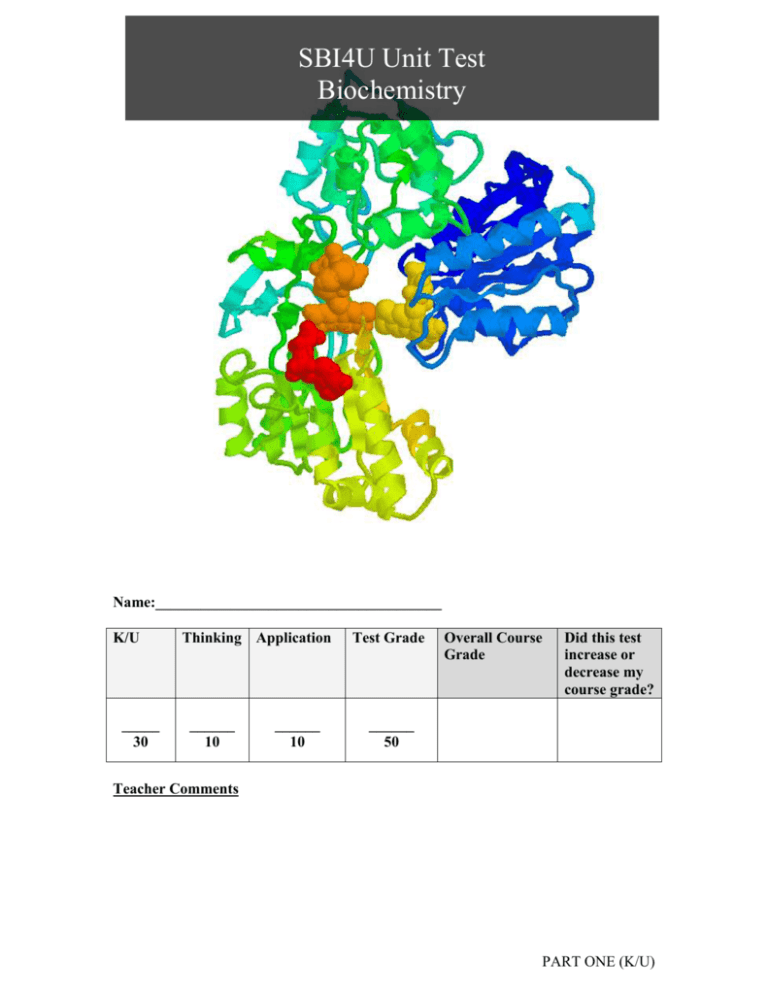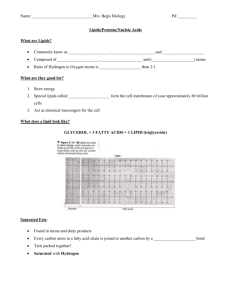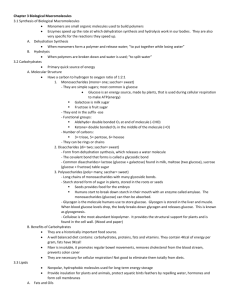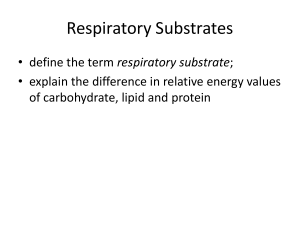SBI4U Unit Test
advertisement

1 SBI4U Unit Test Biochemistry Name:______________________________________ K/U _____ 30 Thinking Application ______ 10 ______ 10 Test Grade Overall Course Grade Did this test increase or decrease my course grade? ______ 50 Teacher Comments PART ONE (K/U) 2 Multiple Choice (K/U - 30 Marks) 1. How many different amino acids are there? a) 2 b) 5 c) 106 d) 20 e) 64 2. C6H12O6 represents a: a) fatty acid d) nucleic acid b) amino acid e) protein c) monosaccharide 3. Which of the following molecules forms the shells of insects, crabs and lobsters? a) nucleic acids d) glycogen b) starch e) all of the above c) chitin 4. Which of the following molecules synthesized by plants most closely resembles the glycogen synthesized by animals? a) lignin d) phospholipase b) starch e) none of the above c) glucose 5. Which of the following is not a component of DNA? a) sugar d) Co-A enzyme b) guanine (base) e) cytosine (base) c) phosphate 6. Which type of fat is the most healthy? a) saturated d) mono-unsaturated b) poly-unsaturated e) unsaturated c) none of the above 3 7. Which type of fats is the most unhealthy? a) saturated d) mono-unsaturated b) poly-unsaturated e) unsaturated c) none of the above 8. Which of the following involves movement from a low solute concentration to a high solute concentration. a) facilitated diffusion d) active transport b) osmosis e) endocytosis c) diffusion 9. Cells that manufacture a high volume of sugar usually contain large numbers of: a) lysosomes d) smooth ER b) mitochondria e) chloroplasts c) rough ER 10. Which component of the cell can be described using the “Fluid Mosaic Model”? a) endoplasmic reticulum d) chloroplasts b) mitochondria e) cell membrane c) cytoplasm 11. This organelle destroys damaged cells and bacteria. a) cell membrane d) Golgi apparatus b) Endoplasmic reticulum e) Lysosome c) Nuclear membrane 12. The site of cellular respiration. a) chloroplast d) stroma b) chlorophyll e) centriole c) mitochondria 13. Which two functional groups are always found in amino acids? a) amino and sulfhydryl d) carboxyl and amino b) carbonyl and carboxyl e) ketone and amino c) alcohol and aldehyde 4 14. Which of the following is TRUE of an amino acid and starch? a) Both contain nitrogen d) Both are hydrophobic b) Both are polymers e) Both are found in proteins c) Both contain a carboxyl group 15. If 100 molecules of the general type shown above were joined together in sequence, the single molecule that would result would be a a) polysaccharide b) polypeptide c) polyunsaturated fatty acid d) nucleic acid e) fatty acid 16. If a scientist wanted to decrease the solubility of a polysaccharide based on the properties of other poly saccharides he/she should a) remove any amino groups present b) alternate the direction/orientation of the glucose molecules c) remove any branches in the glucose molecules d) add hydroxyl groups 17. Which food would likely contain unsaturated fatty acids? a) cooking lard b) margarine c) peanut butter d) olive oil 18. Which molecule would you most likely have a shortage of in the body if you are not consuming enough essential amino acids? a) lipids b) carbohydrates c) nucleic acids d) proteins 5 19. When two glucose molecules or two amino acids combine to form polymers, the type of reaction that occurs is a; a) condensation reaction b) hydrolysis reaction c) decomposition reaction d) oxidation/reduction reaction e) neutralization reaction 20. When a large sugar molecule such as sucrose is broken down into smaller units, the type of reaction that occurs is a; a) condensation reaction b) hydrolysis reaction c) decomposition reaction d) oxidation/reduction reaction e) neutralization reaction 21. Which of the following options is FALSE? a) protein synthesis and DNA synthesis are anabolic processes b) protein synthesis and photosynthesis are anabolic processes c) DNA synthesis and photosynthesis are anabolic processes d) cellular respiration and photosynthesis are catabolic processes e) cellular respiration and digestion are catabolic processes Identify the functional groups that are present in the following molecules. 22. a) carboxyl b) amino c) phosphate d) aldehyde e) ketone 23. a) carboxyl b) amino c) phosphate d) hydroxyl e) ketone 6 Identify the biological molecules that are shown below. 24. a) Triglyceride d) Phospholipid g) Glucose (dry) b) Polynunsaturated Fatty Acid e) Amino Acid h) Polypeptide chain / Protein c) Saturated Fatty Acid f) Glucose (in water) b) Polynunsaturated Fatty Acid e) Amino Acid h) Polypeptide chain / Protein c) Saturated Fatty Acid f) Glucose (in water) b) Polynunsaturated Fatty Acid e) Amino Acid h) Polypeptide chain / Protein c) Saturated Fatty Acid f) Glucose (in water) 25. a) Triglyceride d) Phospholipid g) Glucose (dry) 26. a) Triglyceride d) Phospholipid g) Glucose (dry) 7 27. a) Triglyceride d) Phospholipid g) Glucose (dry) b) Polyunsaturated Fatty Acid e) Amino Acid h) Polypeptide chain / Protein c) Saturated Fatty Acid f) Glucose (in water) b) Polynunsaturated Fatty Acid e) Amino Acid h) Polypeptide chain / Protein c) Saturated Fatty Acid f) Glucose (in water) b) Polynunsaturated Fatty Acid e) Amino Acid h) Polypeptide chain / Protein c) Saturated Fatty Acid f) Glucose (in water) b) Polynunsaturated Fatty Acid e) Amino Acid h) Polypeptide chain / Protein c) Saturated Fatty Acid f) Glucose (in water) 28. a) Triglyceride d) Phospholipid g) Glucose (dry) 29. a) Triglyceride d) Phospholipid g) Glucose (dry) 30. a) Triglyceride d) Phospholipid g) Glucose (dry) 8 SBI4U Unit Test Biochemistry Multiple Choice Answer Sheet Name:______________________________________ Question 1 Multiple D Choice Answer 2 C 3 C 4 B 5 D 6 B Question 7 Multiple A Choice Answer 8 D 9 E 10 E 11 E 12 C Question 14 Multiple B Choice Answer 15 A 16 B 17 D 18 D Question 19 Multiple A Choice Answer 20 B 21 D 22 A 23 D Question 24 Multiple A Choice Answer 25 C 26 F Question 27 Multiple B Choice Answer 28 G 29 E 30 D 13 B SBI4U Unit Test Biochemistry 9 Name:______________________________________ PART TWO (THINKING/APPLICATION) 10 Short Answer (Thinking – 10 marks) 1. A biologist investigating enzyme function plotted the activity of a particular enzyme (y-axis) versus pH (x-axis). Experiment A was performed at 30o C, experiment B at 10oC, and experiment C at 100oC. Experiments A, B, and C all used the same type of enzyme, they simply tested the enzyme’s activity at different temperatures. Using your knowledge of enzyme activity, answer the questions based on the results shown in the graph. a) Explain why lines A and B are so different. (2 marks) Experiment A (30oC) is much closer to the optimum temperature of this enzyme than experiment B. OR An increase in kinetic energy (heat) will normally cause an increase in enzyme activity b) Why is there no hill in the middle of line C? (1 mark) The high temperature has denatured the enzyme. c) After conducting experiment C, the investigator cools the reaction vessel to 30oC and repeats the experiment using the exact same enzyme (not just the same type of enzyme, but the very same enzyme that was that was used in experiment C). In the space provided below, draw the shape of the line that you would expect to see on the graph for this new experiment. (2 marks) 11 2. How can too much protein harm your body? (5 marks) Ketones are a byproduct of the body burning fat for fuel rather than carbs. Too much ketone production can lead to ketosis. Too much protein leads to an excess of toxic ammonia in the system that caused the liver to work harder to remove it. This may lead to liver complications. Can thrust your kidneys into overdrive in order to flush these ketones from your body. As your kidneys rid your body of these toxic ketones, you can lose a significant amount of water, which puts you at risk of dehydration But along with losing water, you lose muscle mass and bone calcium. The dehydration also strains your kidneys and puts stress on your heart. And dehydration from a ketogenic diet can make you feel weak and dizzy, give you bad breath, or lead to other problems. Excessive protein in your diet also increases the risk of osteoporosis because of limited calcium intake. It also results in more acidic blood because when acids break up and enter the blood, it makes it acidic, disturbing the pH level. (2 marks) 12 Application – 10 marks 3. Name three types of food production processes that use enzymes to improve production yields? Explain how enzymes help to improve yields in each case. (3 marks) - - - Rennet is used to speed up the breakdown of milk ingredients to produce casein which is responsible for cheese curd production during cheese making. Rennet contains rennin, an enzyme that converts a common protein in milk called caseinogen into casein, which does not dissolve in water. The casein precipitates out as a gel-like substance that we see it as curd. Use of enzymes to convert cheap starch into corn syrup for pop rather than using more expensive cane sugar Advances in biotechnology have allowed the production of bacteria and yeast strains that contain enzymes tailored to produce certain flavors and product quality Enzymes can be used in the production of compost which is then used for crop production Enzymes that operate within yeasts and bacteria can be biologically engineered to improve quality or taste of beer and wine products. The enzymes are involved in the anaerobic breakdown of sugars into alcohol 13 4. How do the chemical and physical properties of the four main biological molecules affect humans on a structural, functional, biochemical, or cellular level. (7 marks) In other words; how do the four main biological molecules help humans to survive on a daily basis? (2 marks) Proteins Enzymes are proteins – digest food, carry oxygen, function in the immune system, form the structure of our tendons, muscles, skin, hair, nails, ligaments (2 marks) Carbs – provide energy cellular and physiological functions such as growth, reproduction, healing, form glycogen for quick energy release, form backbone of dna which makes proteins (2 marks) Fats (lipids) – form cell membrane, protects organs, provides energy storage, produces steroids and hormones (1 mark) DNA and RNA – provides instructions on how to make proteins









